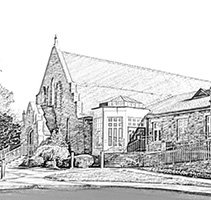Update on Events from March and Zoom Tips
Date: Apr 15, 2025
Category: Archive, Stories
Series: 2025
Author: Kerry Griffin
Breaking News! Sondra Knox has stepped down as Administrative Assistant. The position is currently open. Conta ...
Breaking News! Sondra Knox has stepped down as Administrative Assistant. The position is currently open. Conta ...
Some notable recent events include our Administrative Assistant Sondra Knox has had her first anniversary with ...
On Sunday, January 12th (Baptism of our Lord), guest Preacher Susan Beck asked if our baptismal font had any h ...
Sunday school memories of Carolyn Frost and the featured item of the month in the archive, the baptismal ewer.
Thanks to a generous donor, the archive now has an archival cabinet in the narthex and this month's feature is ...
How quickly this month has flown by as always for this time of year. The Holiday Bazaar was a smashing success ...
In a previous issue I introduced the new website and it has been a journey from the project beginning in April ...
Curious about how much it cost to build our parish hall in 1958? Do you remember 1972 at St. Paul? Read on to ...
Article from the "Ellicott City News Leader" July 30, 1964, detailing the wedding of Charles and Jud ...
Feature Archive Story November 2023
St. Paul’s version of the “Last Supper’’. Our version executes some of the traditional elements. However, notice in this version the table is semi-round in the Jewish tradition and there is nothing on the table as in Leonardo’s and there is a faint image of an altar as well as a suggestion of foot washing in the lower left corner. It is fittingly located beneath our Trinity Stained Glass window.
C. Ellsworth Iager (Charles Iager’s father) bought the picture around 1980 and it is an original depicture of the “Last Supper” done by an artist. C. Ellsworth and Mary Elizabeth Iager (married 49 years) donated it to the church and took a lot of pride in giving it and having it hung up. They were very humble about it and very proud of finding it because they loved it.
C. Ellsworth was President of the Church Council several times. Building the parsonage and the 100th Anniversary took place while he was President. Ellsworth sang in the choir for many years.
The purpose of this photo Gallery is to document the variety of banners that enhance our worship here at St. Paul’s through countless hours, talent and treasure of all those who have contributed to make them possible.
The banners contained here in take us through the Church year: Advent, Christmas, Epiphany, Lent, Pentecost and the sacraments of marriage and baptism as well as the rite of confirmation.
Although Church banners are not new to the St. Paul’s they do more than just decorate, many are based upon passage’s from the Bible and God’s creation and remind us of His word and the beauty of creation as well as marking important milestone in St. Paul’s congregation’s life.
Most of St. Paul’s banners are hand sewn and one their creators, Sandy August is particularly fond of adding a ribbon. Make note of the special fabric used in some of them, such as the Advent banners. The photos may not do them justice but they have an unusual impression in them similar to a watermark on paper.
Please browse by clicking the forward arrow “>” or the backward “<” arrow on the image below. There are at present about 60 in the collection.
I happened upon a 2009 Booklet about the Stained Glass of St. Paul’s and the meaning of each of the various windows at St. Paul’s written I believe by Prue Ronneberg and I was inspired to re-do the booklet in a larger format and update it to present 2017. Below is the resulting story.
Please browse by clicking the forward arrow “>” or the backward “<” arrow on the image below. There are at present 20 pages in the collection.
To stay up to date on what’s going on, and get inspirational messages, make sure you follow us on social media.
